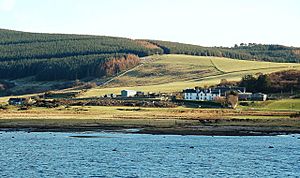Battle of Loup Hill facts for kids
Quick facts for kids Battle of Loup Hill |
|||||||
|---|---|---|---|---|---|---|---|
| Part of Jacobite risings | |||||||
 Loup House |
|||||||
|
|||||||
| Belligerents | |||||||
| Commanders and leaders | |||||||
| William Young | Gorrie McAlister MacNeill of Gallachoille |
||||||
| Strength | |||||||
| 500 | 200 | ||||||
| Casualties and losses | |||||||
| None | 2 killed | ||||||
The Battle of Loup Hill happened near Loup Hill in Kintyre, Scotland. It took place on May 16, 1689. This battle was part of the Jacobite rising of 1689. This rising was linked to a bigger war in Ireland.
In early May, supporters of King James, called Jacobites, took control of northern Kintyre. Government troops arrived to take the area back. They walked into a surprise attack on the slopes of Loup Hill. Even with the high ground, the Jacobites did not fight well. They quickly ran away. A few days later, they left Kintyre completely.
Not many people were hurt on either side. The battle was a small fight. But losing Kintyre was a big problem for the Scottish rising. It meant their friends in Ireland could not easily send them supplies.
Contents
Why Did the Battle Happen?
A New King for Scotland
In 1685, James II & VII became king. He was Catholic. Many people in England and Scotland supported him at first. They remembered the Wars of the Three Kingdoms (1638-1651). These wars had caused a lot of trouble. People wanted peace and stability.
Most Scots belonged to the Church of Scotland. This church was Protestant. Very few Scots were Catholic. In 1681, a rule said public officials had to be part of the Church of Scotland. King James tried to change this rule. This made some of his own supporters unhappy.
Changes to the Royal Family
In June 1688, two big things happened. First, King James had a son, James Francis Edward Stuart. This meant there could be a line of Catholic kings. Before this, James's Protestant daughter, Mary, was next in line. She was married to William of Orange.
Second, King James put seven bishops on trial. People thought he was trying to attack the Church of England. The bishops were found not guilty. This made King James lose a lot of his power.
By 1688, many people feared civil war if James stayed king. William of Orange landed in England in November with 14,000 soldiers. King James's army left him. James went to France in December. In February 1689, the English Parliament offered the throne to William and Mary.
Scotland Chooses a Side
On March 14, a meeting happened in Edinburgh. This meeting was to decide Scotland's future. Most people at the meeting supported William and Mary. The "Jacobites" were those who supported King James. But most Scots did not strongly support either side.
On March 12, King James landed in Ireland. On April 11, the Scottish meeting offered the Scottish throne to William and Mary. The next day, a leader named Dundee started the rebellion. He raised the Royal Standard in Dundee. This was the official start of the Jacobite rising.
The Battle of Loup Hill
Why Kintyre Was Important
Scottish MacDonalds and Irish MacDonnells were very close. Also, Protestants in Ireland and Argyllshire were connected. This meant fights in one country often spread to the other. By April, most of Ireland was held by Jacobites. Only one city, Derry, was still held by Protestants.
Kintyre was a very important place. It allowed the Jacobites to get supplies from Ireland. They used small boats for this. This was key because the new government controlled all the main Scottish ports.
Local Fights and Loyalties
Choosing sides often came down to local rivalries. It was not just about supporting the Stuarts or religion. Kintyre used to be controlled by the MacDonalds and MacAlisters. But in the 1670s, the powerful Campbells took over.
After a rebellion in 1685, the original owners got their land back. But with the new government, the Campbells were back in power. This meant the MacDonalds and MacAlisters might lose their independence again.
Government Troops Arrive
In April, Campbell soldiers took over Tarbert Castle. Soon after, a French ship with Irish refugees arrived nearby. This made people fear an Irish invasion. The government knew they needed to control Kintyre. But they did not have many soldiers. New army groups were still being formed.
About 500 men were gathered under Captain William Young. They were sent by small boats to Tarbert. They landed on May 15.
The Ambush at Loup Hill
Local Jacobite chiefs believed they would get help from Ireland. These chiefs included Gorrie Macalister and Macneill. They declared their support for King James. They took over Skipness Castle. This castle was on the eastern side of the peninsula.
This blocked Captain Young from moving south. So, he moved across the peninsula instead. He planned to take over the chiefs' homes. As he moved, he met 200 Jacobite soldiers. They were led by Macneill and Gorrie Macalister. They were waiting on the slopes of Loup Hill.
Captain Young reported that both sides fired shots. Then the Jacobites ran away. Young's force had no injuries. They found only two enemy soldiers who had died. Young decided not to chase them. His soldiers were new and not ready for a night attack. He continued to Clachan. There, he met more local government supporters.
What Happened Next?
The Jacobite chiefs realized they were outnumbered. They left Kintyre to the government. They escaped to Ireland. Some of them later fought in the Battle of Killiecrankie in July. They were later declared outlaws for treason.
Images for kids


